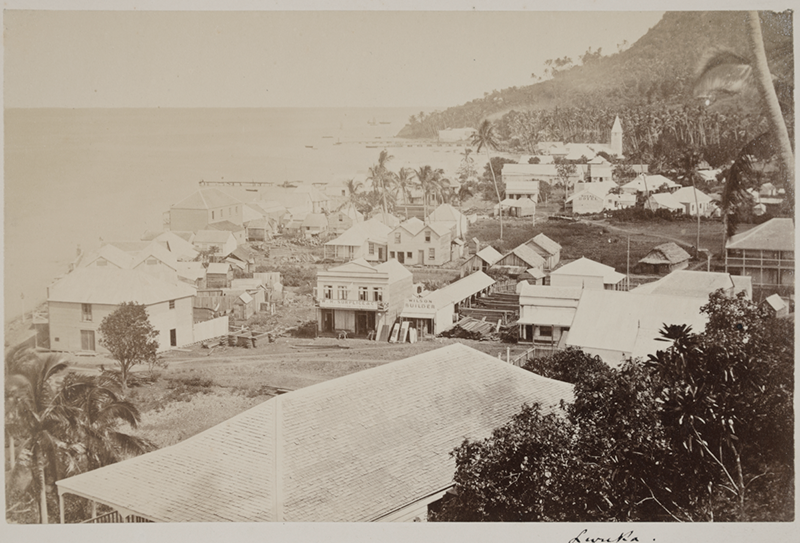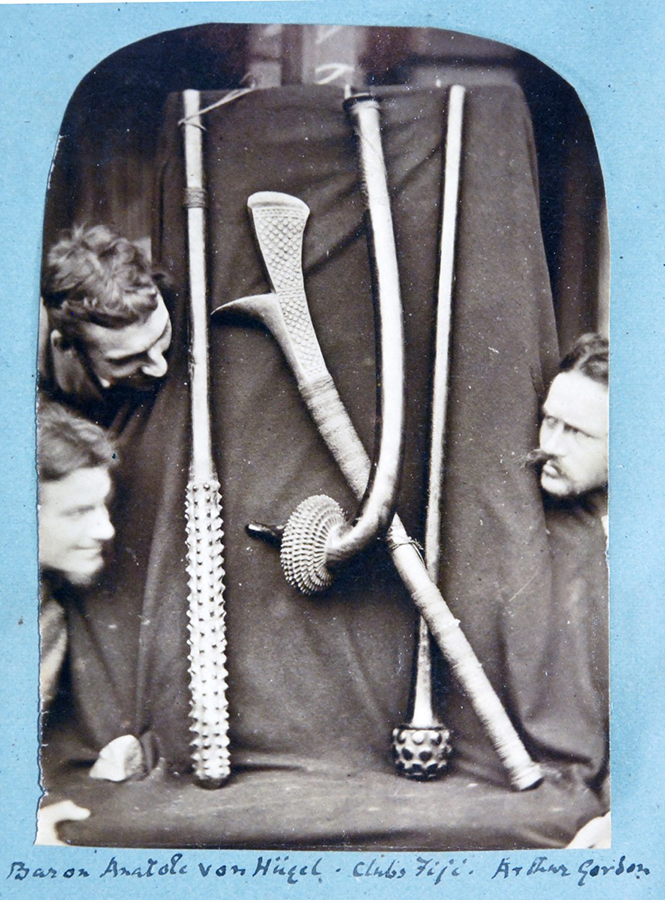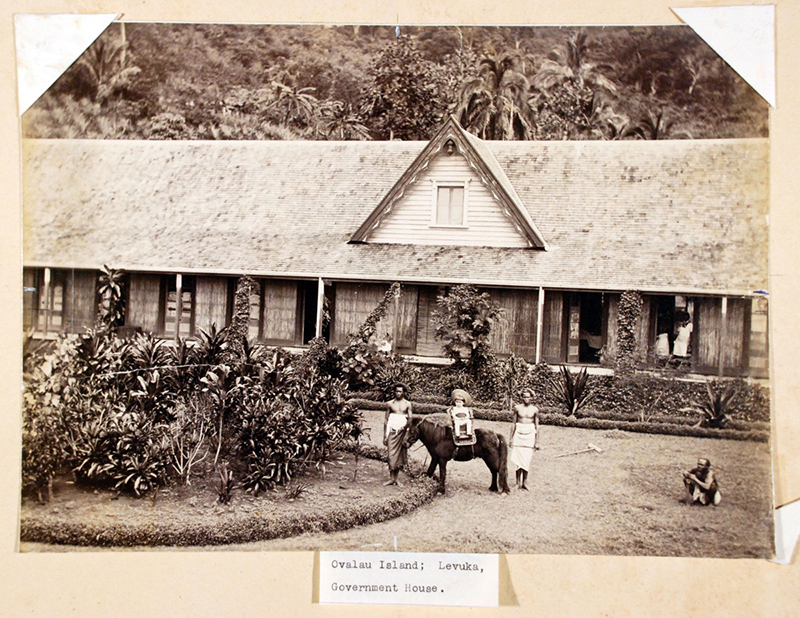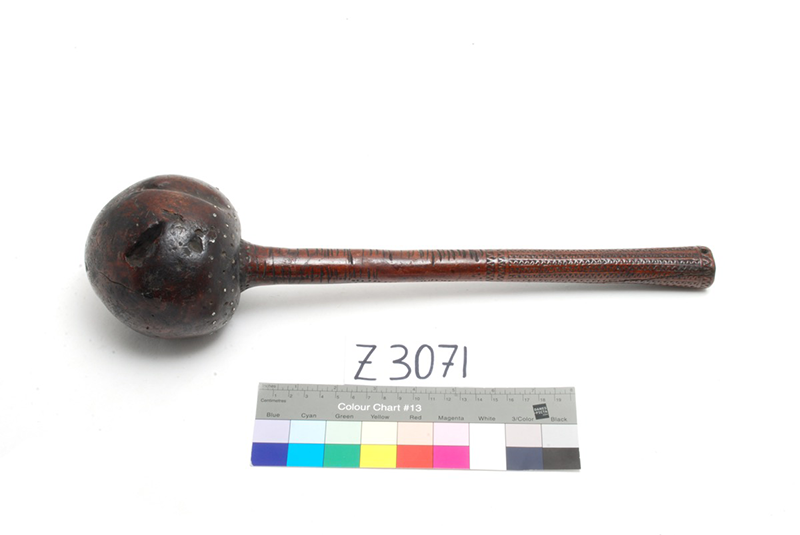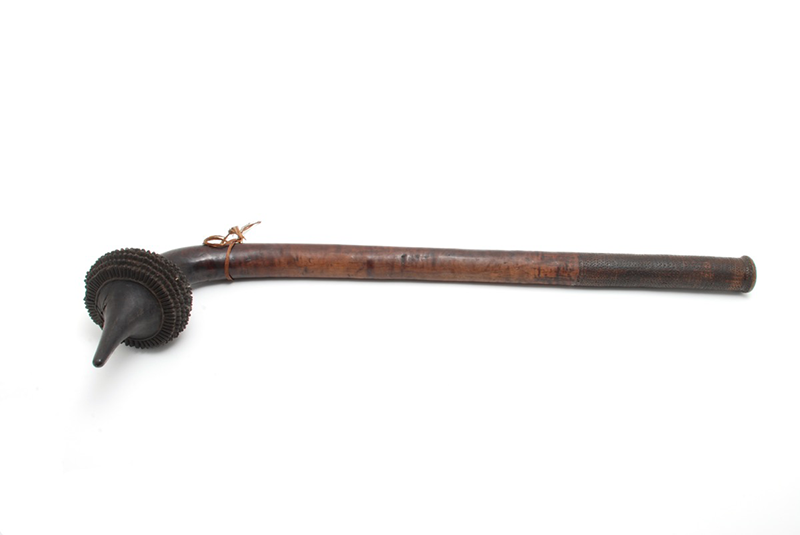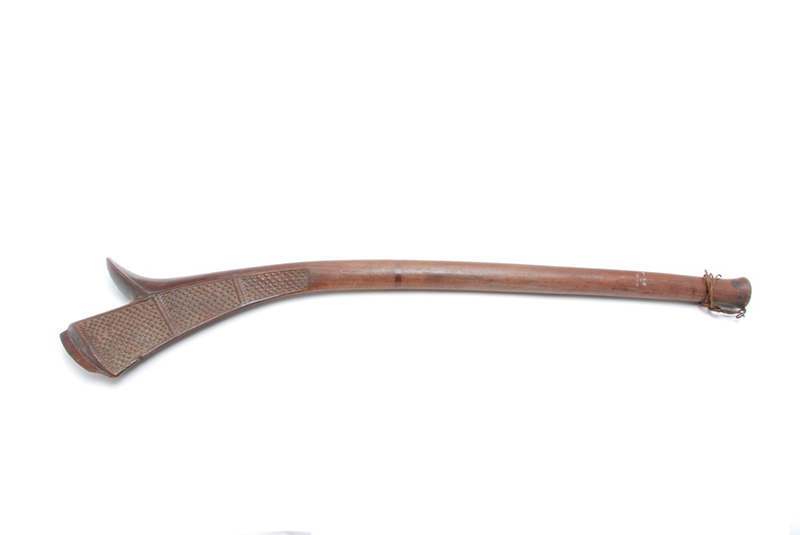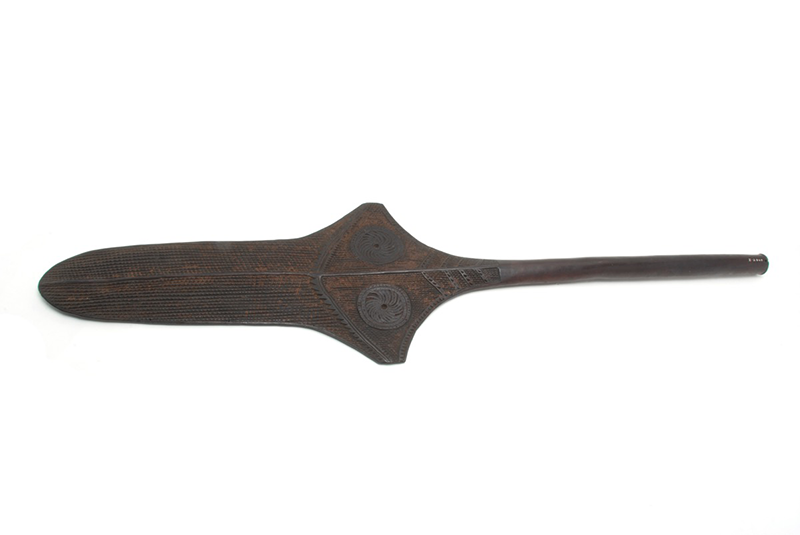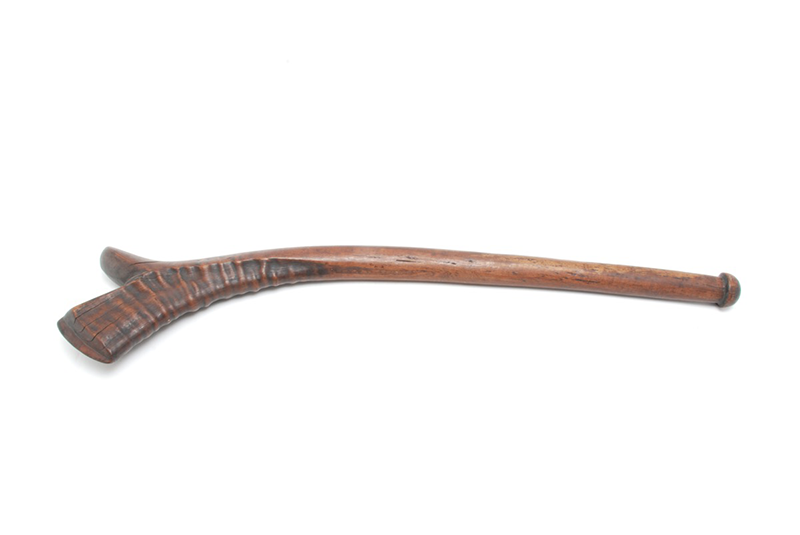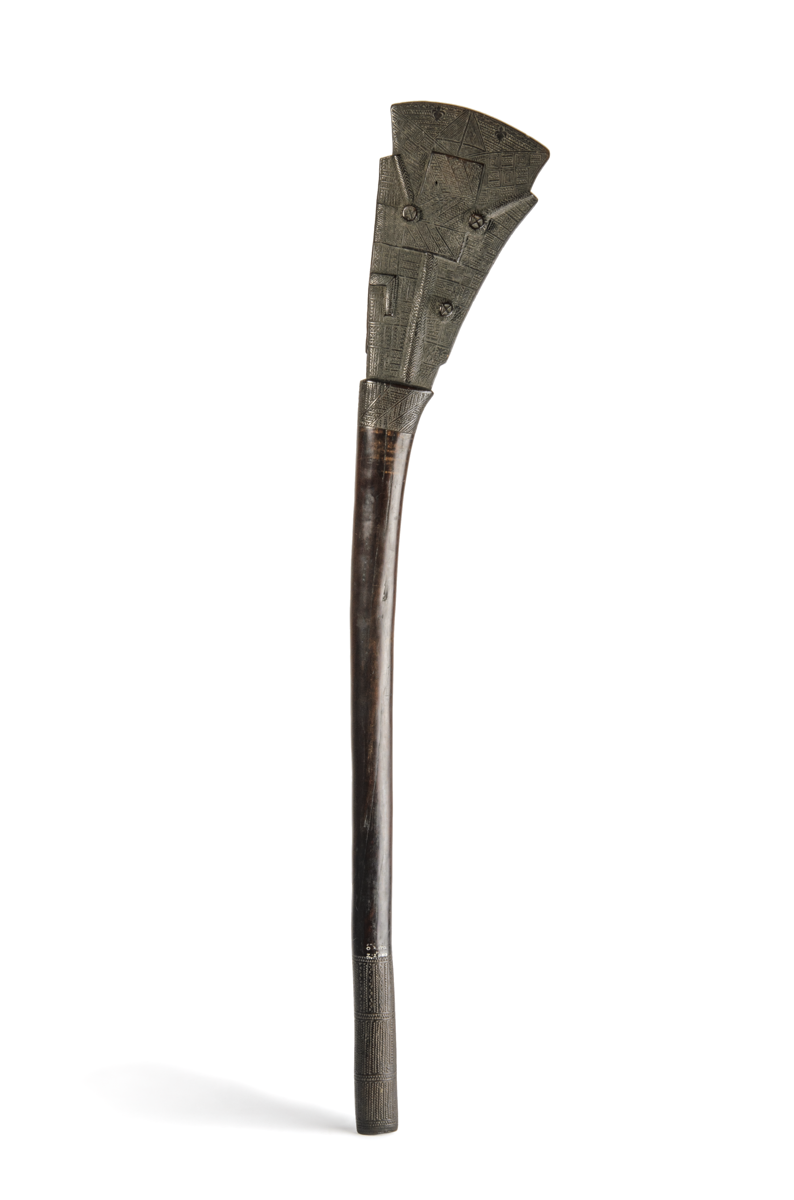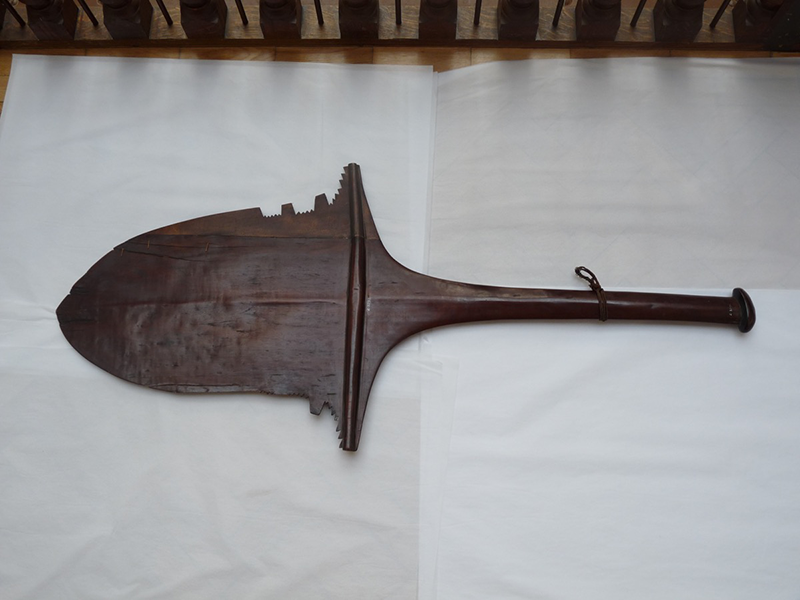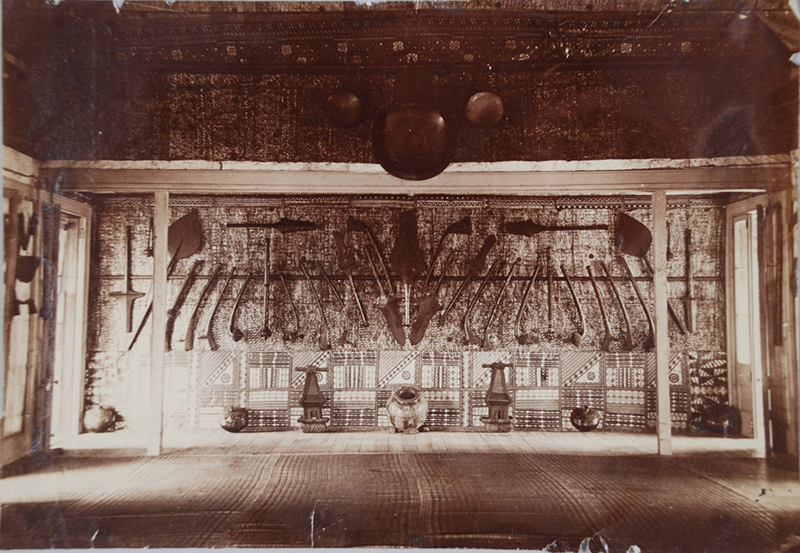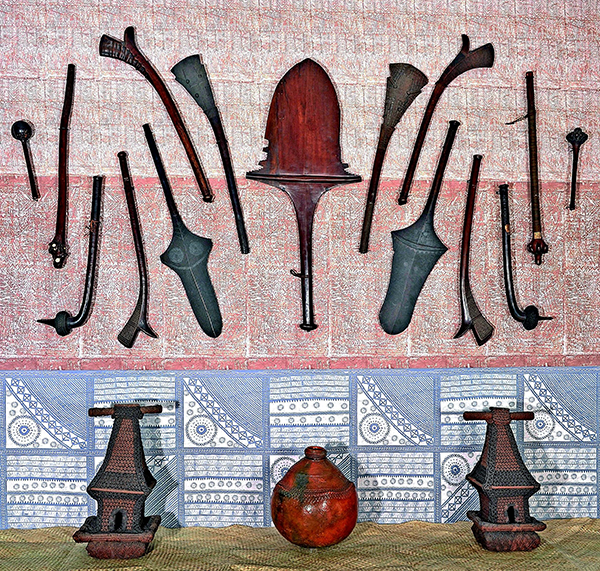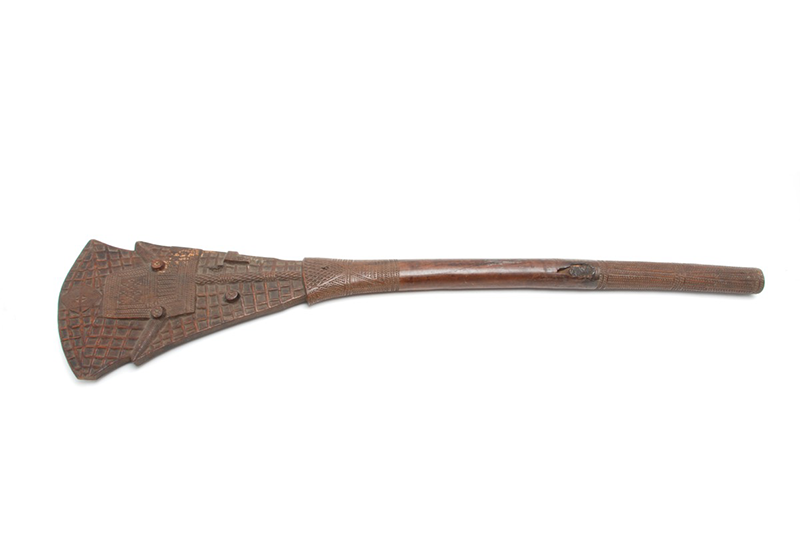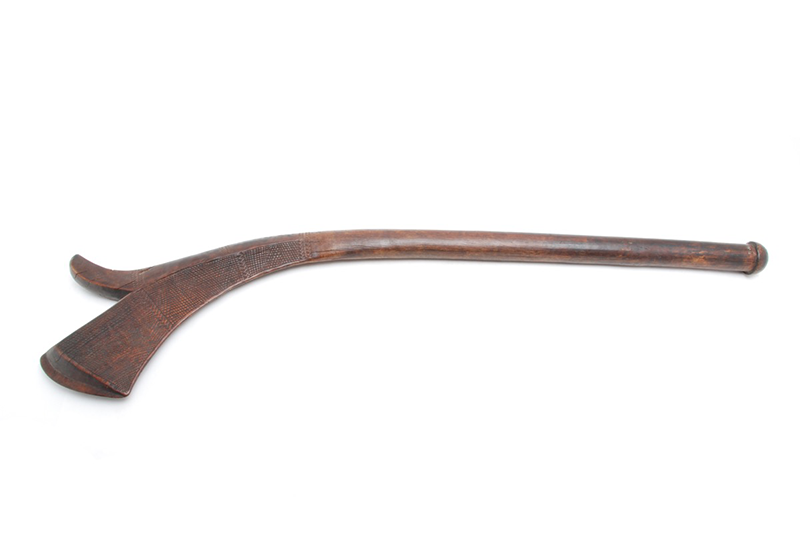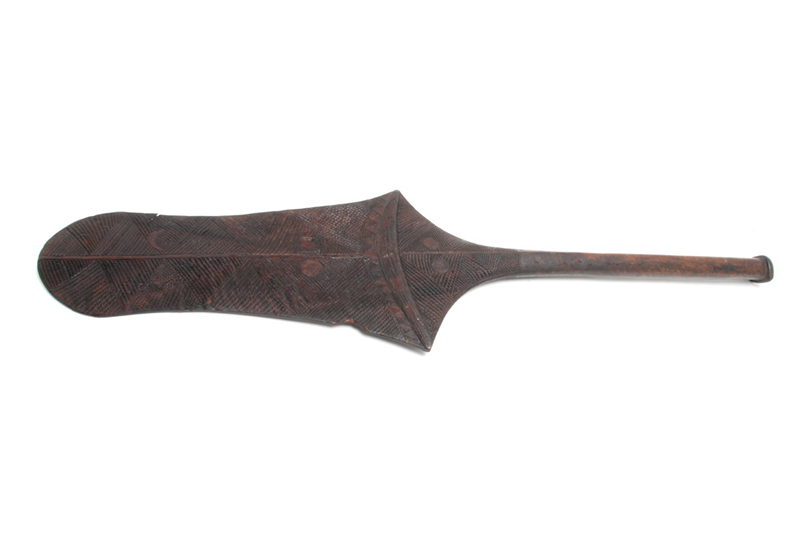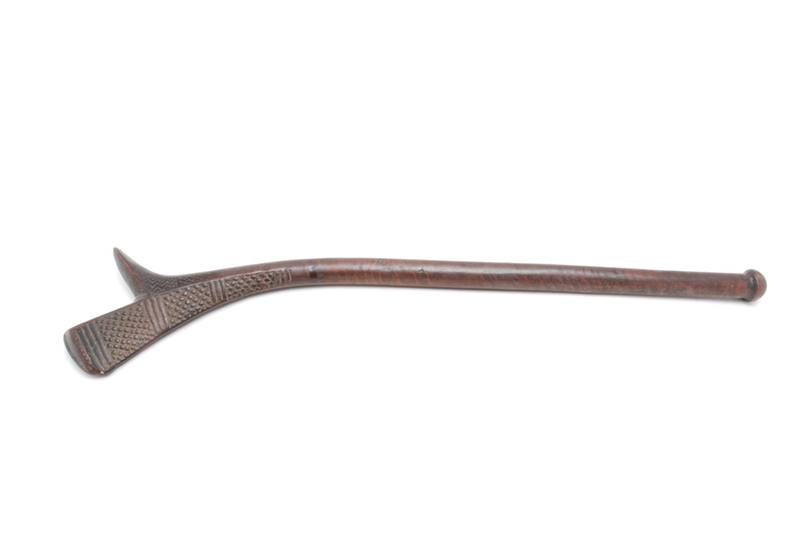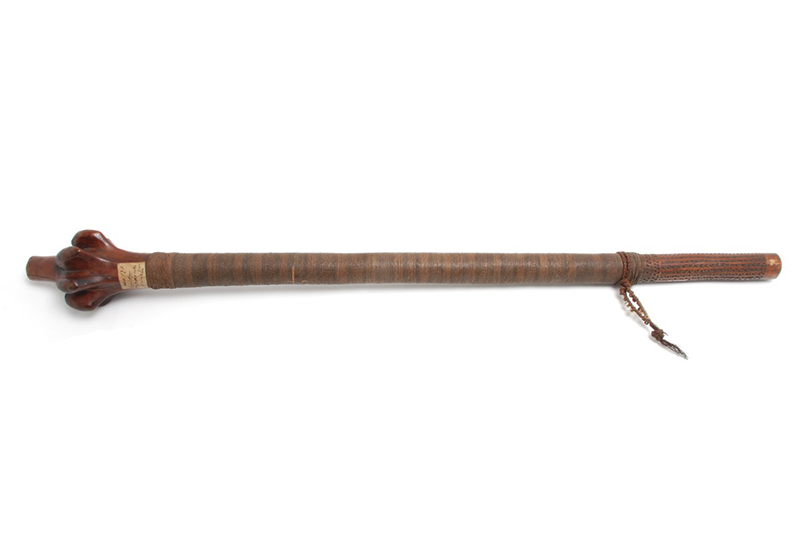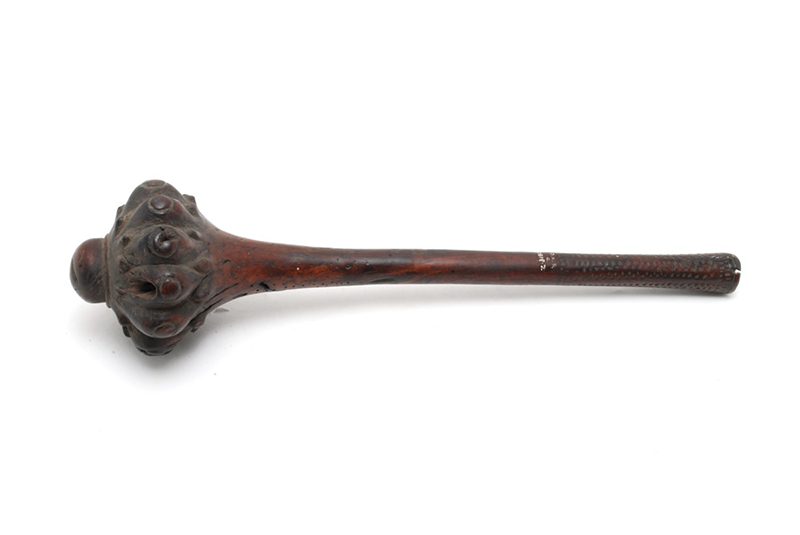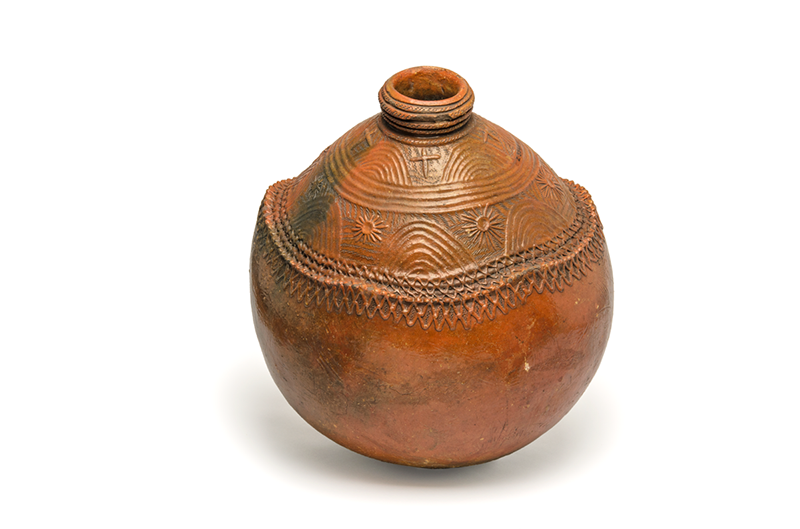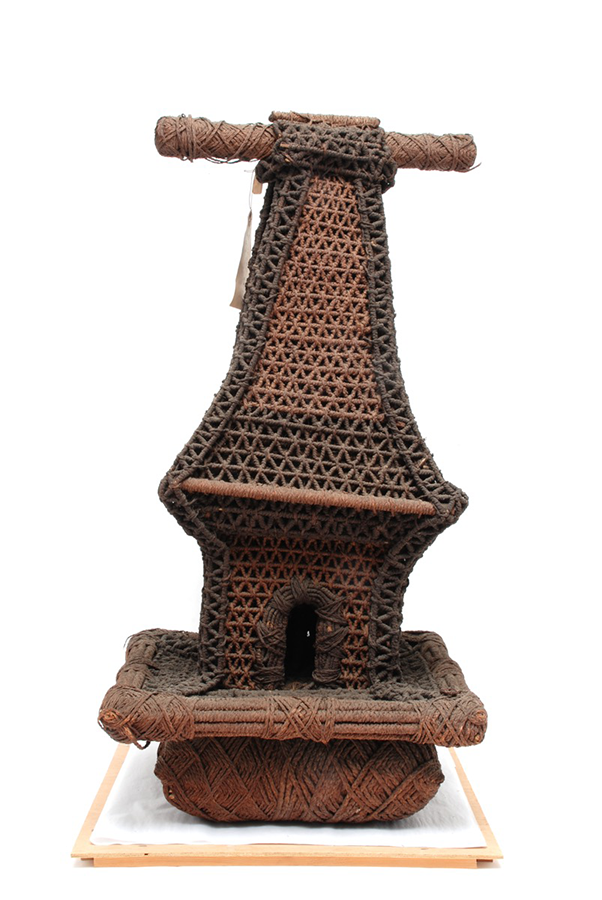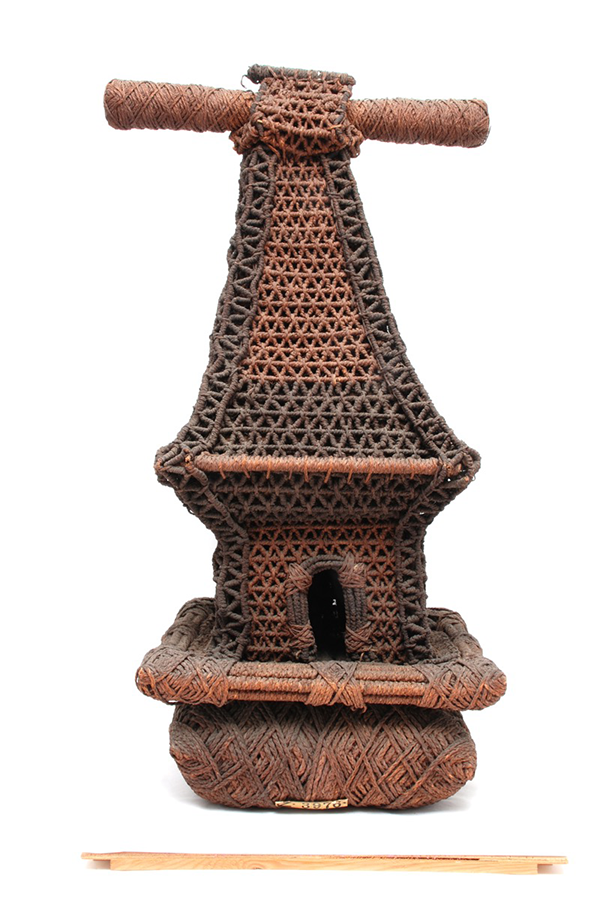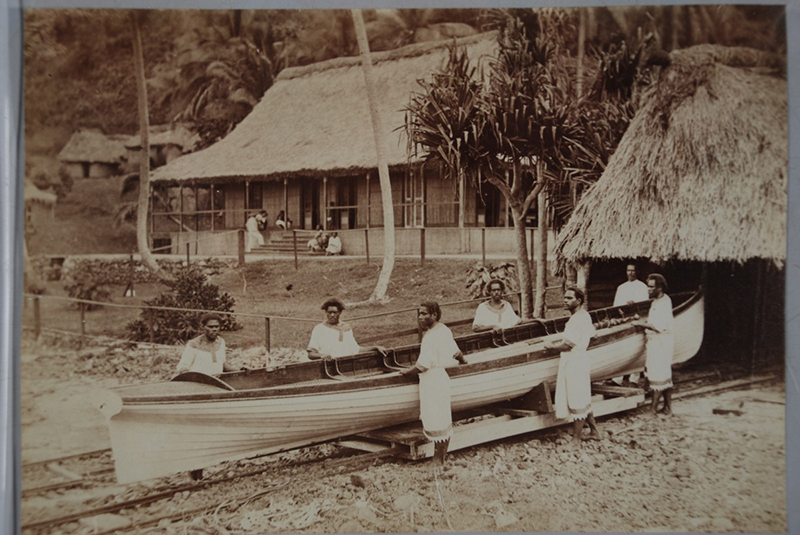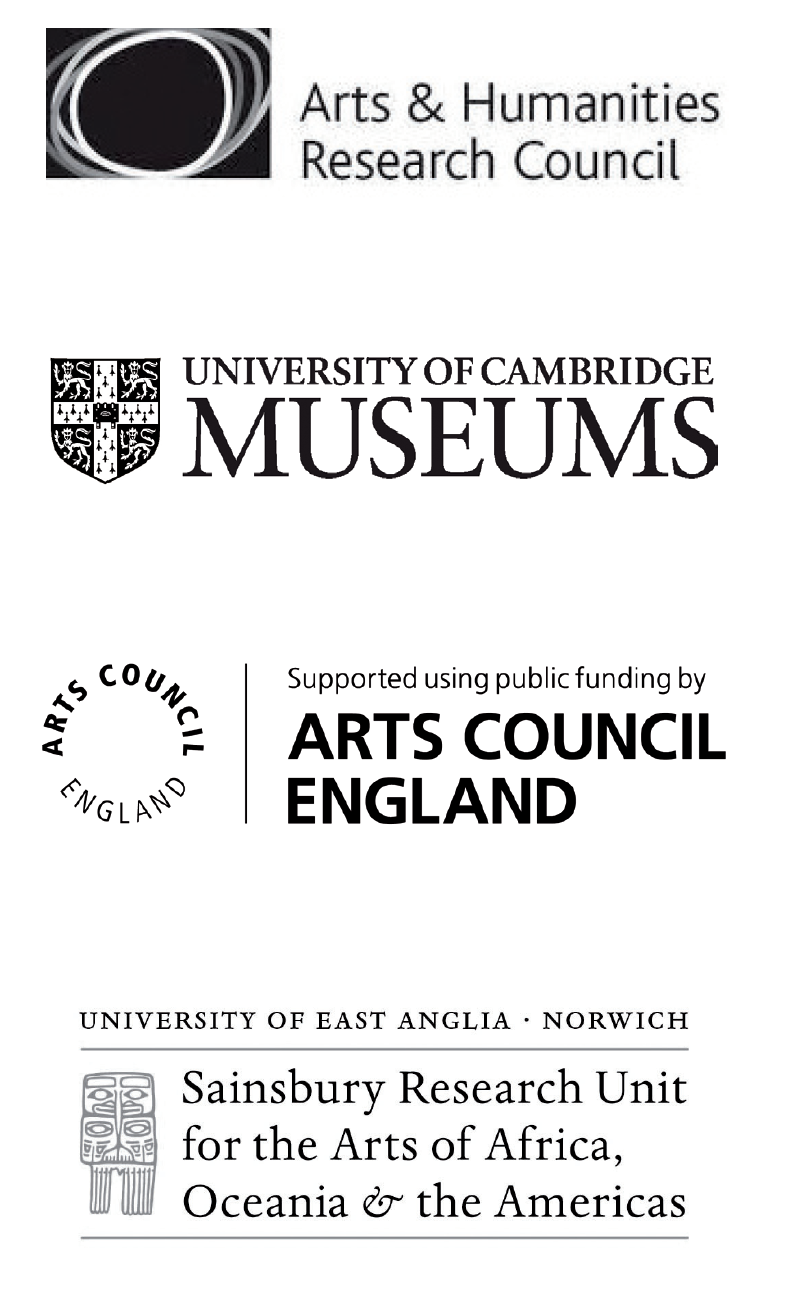Government House was located at Nasova, about a mile from Levuka. It was the seat of government and a domestic residence. Official business often intersected with domestic affairs.
Government House. The buildings combined Fijian architecture and materials with European-style gables. The grounds included a western Viti Levu-style house with conical roof and a Tongan-style volau boatshed covered in white cowry shells, symbolic of sacredness and authority. Photographed by F. Dufty, 1875-76, Nasova, Ovalau Island, Fiji. P.103577.VH
Lady Gordon arrived on 19 September 1875, with her two children, Nevil and Jack, and her personal travelling companion Constance Gordon Cumming. Von Hügel was already in residence with a large collection of material obtained during his travels throughout Viti Levu. The other members of Government House were actively acquiring Fijian objects and Lady Gordon expressed delight in obtaining unusual things. Their shared interests in collecting prompted a friendly rivalry.
This exhibition installation evoked the dining room at Government House. Lady Gordon, assisted by Maudslay and von Hügel, used the assembled collections to decorate the room. Writing to her sister, she described:
"the mania for collecting curiosities with which we have all been bitten... Such beautiful and artistic patterns can be made with clubs, spears, bowls, arrows, axes, paddles, etc. We have an immense collection of these things... increasing every day."
The dining room was a key setting for social engagement, with dinner parties that often included leading Fijian chiefs and members of Levuka society. The symmetrical arrangement of the collections is in keeping with Victorian sensibilities. Fijian chiefs and priests had a long history of displaying weapons and other valuables, often within spirit houses. The dining room materialised and combined Fijian and colonial notions of chiefly presentation and display.
Use the drop down menu to explore the objects within this section.
The Rival Collectors. A. von Hügel, A.J.L. Gordon and Captain L. Knollys looking over a display of Fijian clubs. Photographed by F. Dufty, 18 August 1875, Levuka, Ovalau Island, Fiji. P.98952.GCUM
"Rooms are large and very airy, the walls being made in the native fashion, of reeds, so that the breeze passes right through; the roof is thatch and the floor cement… as far as coolness is concerned, this is the best tropical house I have ever seen."
- Arthur J. L. Gordon’s letter to his mother, 15 July 1875.
A small child, possibly the Governor’s son, Jack, seated on a pony with two Fijian attendants in front of Government House. Note the combination of Fijian and European-style architecture.
Nasova, Ovalau Island, Fiji. Collected by A. von Hügel, 1875-77. P.99680.VH
"To the first dinner we had the ex-King Thakombau [Cakobau]… a fine dignified old man, with a most commanding manner, and perfectly at his ease… Yesterday Maafu [Enele Ma’afuotu’itonga], the great Tongan Chief came; he is an extremely clever man, and the handsomest of them all."
- Lady Gordon's letter to Lady Shaw-Lefevre, October 1875.
The printed cloth used as a backdrop to this installation is taken from two pieces of barkcloth in MAA’s collection: a Tongan-style rubbed barkcloth at the top and a piece of stencilled Fijian-style masi at the bottom (Z 30436 & Z 30626).
The mat was made specially for this exhibition by Mrs Milly Rayawa in Suva in 2013.
Inlaid with pieces of whale ivory and possibly a human tooth. The base of the head is inlaid with tiny white glass beads. The shaft is imprinted with notches and circular burnt marks, possibly commemorating the time elapsed after a death.
Fiji. Collected by Capt. L. Knollys, c. 1876. Acquired by A. von Hügel from W. D. Webster, 1902. Z 3071
Vunikau translates as ‘tree-root’, from which the head of this type of club is carved. The buttress roots have been cut off. The head and butt are inlaid with large star-shaped pieces of whale ivory.
Fiji. Provenance unknown. Z 39431
Totokia take their shape from the fruit of the pandanus tree (balawa). In order to give a better grip, the handle is carved with geometrical patterns in low relief. In this case, repeated handling has smoothed the surface.
Fiji. Collected by Sir A. Gordon, 1875-80. Z 3094
Sali are probably named after the clawed flower of one of the wild banana-like plants (Musa species) found in the Fiji bush. The ripple visible in the wood is characteristic of Casuarina wood (nokonoko).
Fiji. Collected by A. Maudslay, 1875-80. Z 3048
Traces of red pigment on the surface may indicate that this kinikini was used in dances, when weapons were adorned with pigments, fresh leaves or feathers. This enhanced their effect visually as well as aurally.
Fiji. Collected by Sir A. Gordon, 1875-80. Z 2968
Spurred clubs like this one have often been referred to as ‘gunstock clubs’ because of their resemblance to muskets. However, they were in use in Fiji prior to the introduction of firearms. The underside of the head was pounded into shape in the growing tree with stones before the club was cut.
Fiji. Collected by A. von Hügel, 1875-77. Z 3044
The head is carved with turtles, birds and an anthropomorphic figure in low relief. Objects were often exchanged between residents at Government House, which might explain why the provenance of this club is uncertain.
Fiji. Collected by A. Maudslay or A. von Hügel, 1875-80. Z 2983
Although undecorated, the exquisite finish and scale of this huge paddle-club suggests it belonged to a high-status person. It is likely that culacula took their shape from the culacula crab, the serrated sides of the paddle recalling spikes on the side of the crab’s shell. The left section of the club is probably a 20th-century replacement.
Originally from Fiji. Acquired by A. von Hügel from Roe, 1906, Cambridge. Z 3293
The back wall of the dining room at Government House. The arrangement of weapons, bowls, pottery and spirit houses on a gatuvakaviti barkcloth, was overseen by Lady Gordon with assistance of Alfred Maudslay and Anatole von Hügel.
Nasova, Ovalau Island, Fiji. Collected by A. von Hügel, 1875-77. P.27782.VH
"The dining-room is now beautifully decorated with trophies of spears and clubs, and great bowls, and native cloth. The house is all so thoroughly in keeping with the country; so infinitely preferable to any attempt at making a Europeanised “Government House,” and so much more suitable to Sir Arthur’s rôle of premier chief of Fiji."
- Constance Gordon Cumming’s letter to her sister, 28 March 1876.
Installation at MAA, evoking the original Dining Room at Government House.
Siriti clubs take their shape from the butterfly fish (Chaetodontidae). They were probably used for dances and ceremonies rather than war.
Originally from Fiji. Acquired by A. von Hügel from S. Fenton, 1889, London. Z 2974
Often used in dances, sali were also efficient weapons. On a battlefield, the bladed cheeks of these clubs were designed to cut through bone rather than smash it. The head of this sali is carved with a fine grid and zigzag patterns (tavatava).
Fiji. Collected by Sir A. Gordon, 1875-80. Z 3033
Kinikini were often carried as symbols of authority. Their blades are usually carved with fine tavatava patterns, broken up by plain crescent and circular patterns in the uncarved wood.
Fiji. Collected by A. Maudslay, 1875-80. Z 2966
The cheeks of sali spurred clubs were often decorated with panels of zigzags and circles in relief. Here, the back and the top of the spur is carved with delicate bands of zigzags formed of small indented dots.
Fiji. Collected by A. Maudslay, 1875-80. Z 3051
The handle of this totokia is carved with fine Maori-style patterns. Four circular burnt marks are imprinted into the curved part of the head. Von Hügel’s label adhered to the shaft suggests that this club was made on the island of Nairai.
Viti Levu Bay, Ra, Viti Levu, Fiji. Collected by A. von Hügel, 1875-77. Z 3111
Many clubs used to be bound with plaited coir cords (magimagi). Here the binding is affixed on top of strips of barkcloth and combines three different colours: light red, dark red and black. A cord of plaited coir attached to the handle is threaded with white shell beads.
Narokorokoyawa, Wainimala River, Viti Levu, Fiji. Collected by A. von Hügel, 1875-77. Z 3150
Throwing clubs with flanged heads were one of the most common types found in Fiji. This example is unusual because of the circular motifs carved on the flanges of the head. The small burnt circles at the top of the shaft may commemorate the death of someone important.
Fiji. Collected by Sir A. Gordon, 1875-80. Z 3182
This water pot is the largest in MAA’s collection. It is decorated with bands of zigzags (tavatava) reminiscent of those found on clubs and priest’s dishes. The cross shapes near the neck may be Christian crosses, a motif that became incorporated into Fijian art from the mid-19th century.
Fiji. Collected by A. von Hügel, 1875-77. Z 3546
These miniature spirit housesare likely to be those depicted in the original picture of the dining room at Government House. Three examples, all displayed in this gallery, were collected by the staff and guests of Sir Arthur Gordon.
Fiji. Collected by Sir A. Gordon, 1875-80. 1918.213.26 A & B
Governor Gordon’s boat in front of the boatshed at Government House. The crew are members of the Armed Native Constabulary.
Nasova, Ovalau Island, Fiji. Collected by A. von Hügel, 1875-77. P.87407.VH
Digitised as part of the Fijian Art research project, this album includes watercolour drawings of Fijian objects and landscapes made by Constance Gordon Cumming, as well as photographs, including many cartes-de-visite. The objects depicted here were collected by some of the residents of Government House. Many have joined the collections of MAA.
‘Fijian Manufactures’ by C. Gordon Cumming, 1870s-1880s. Z 4152 / Album 169


